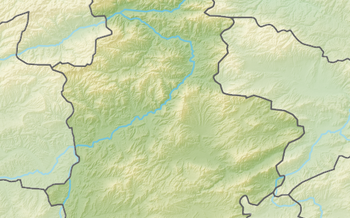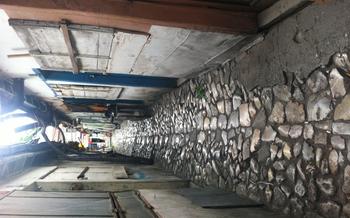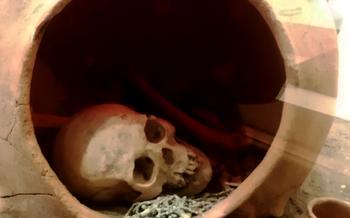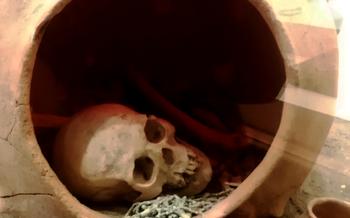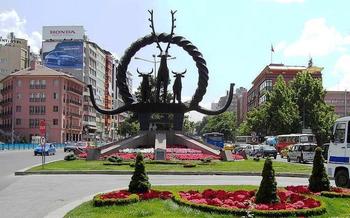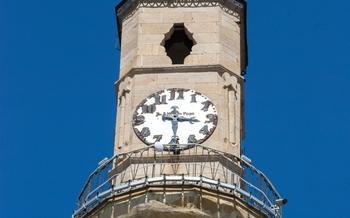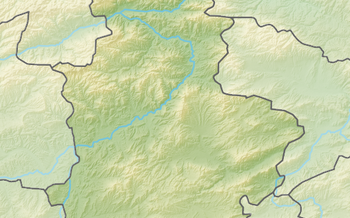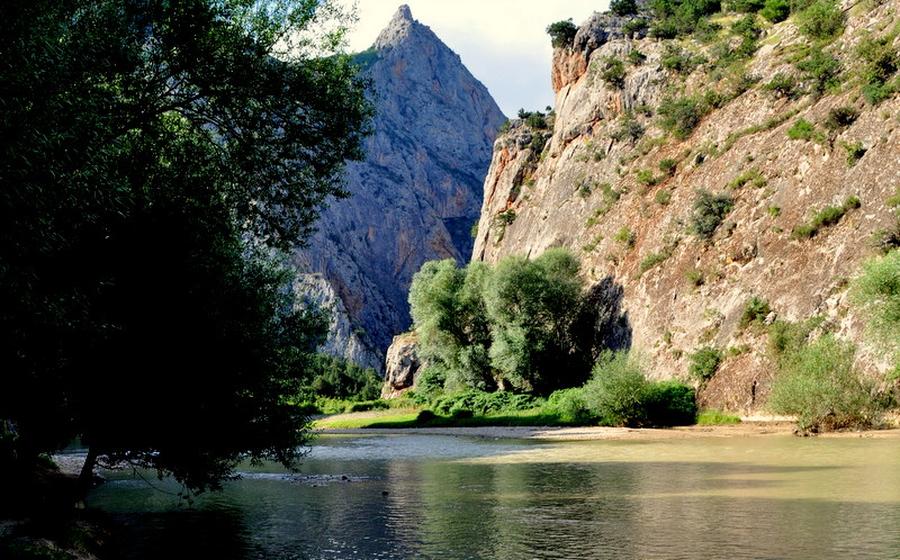
Hittite Dam ancient dam construction from the Hittite era
- A Masterpiece of Ancient Engineering
- Historical Context
- Location and Accessibility
- Exploring the Dam
- Water Management System
- Historical Significance
- Visitor Center and Museum
- Scenic Views and Photography
- Nearby Attractions
- Local Cuisine and Restaurants
- Accommodation Options:
- Souvenirs and Handicrafts
- Festivals and Events
- Safety and Precautions
- Insider Tip:
A Masterpiece of Ancient Engineering
The Hittite Dam, built around 1600 BC, stands as a testament to the advanced engineering skills of the ancient Hittites. Constructed using massive stone blocks, the dam spans approximately 180 meters in length and 15 meters in height, making it one of the largest dams of its time. Its remarkable design and construction techniques showcase the Hittites' mastery of hydraulic engineering. Unlike other ancient dams, the Hittite Dam features a unique spillway system that effectively regulates water flow and prevents flooding. Additionally, the dam served as a crucial water reservoir, providing irrigation to the surrounding agricultural lands, highlighting its significance in sustaining the region's economy and food production.
Historical Context
The Hittites were an ancient civilization that flourished in Anatolia, the region now known as Turkey, from around 1600 to 1200 BCE. They were renowned for their advanced engineering skills, particularly in hydraulics and water management. Çorum, located in central Anatolia, was a significant city in the Hittite Empire and served as a major hub for trade and agriculture. The Hittites constructed several impressive structures in Çorum, including the Hittite Dam, a testament to their engineering prowess and their commitment to water management.
The Hittites possessed a sophisticated understanding of hydraulics, enabling them to design and construct dams, canals, and irrigation systems. Their knowledge of water management was crucial for sustaining agriculture in the arid climate of Anatolia. The Hittite Dam, built around 1500 BCE, stands as a remarkable example of their engineering expertise and their ability to harness water for agricultural purposes.
Location and Accessibility
The Hittite Dam is situated in the province of Çorum, in central Turkey, approximately 240 kilometers (150 miles) northeast of the capital city of Ankara. It is located in the fertile Çorum Plain, surrounded by rolling hills and agricultural fields. The dam is easily accessible by road, with well-maintained highways connecting it to major cities and towns in the region. Visitors can take public transportation, such as buses or trains, to Çorum city and then hire a taxi or rent a car to reach the dam site. The city of Çorum offers a range of accommodation options, from budget-friendly guesthouses to comfortable hotels, catering to the needs of travelers.
Exploring the Dam
The Hittite Dam stands as a testament to the engineering prowess of the ancient Hittites. The structure, which is approximately 180 meters long and 20 meters high, showcases their mastery of hydraulic engineering. Constructed using massive stone blocks, the dam features a trapezoidal shape with a slightly curved upstream face. Its impressive thickness, ranging from 15 to 20 meters, adds to its stability and longevity.
The dam comprises several distinct parts, each serving a specific function. The spillway, located at the dam's center, controls the flow of excess water and prevents flooding during heavy rainfall. The abutments, situated at both ends of the dam, provide support and stability to the structure. The apron, built downstream, dissipates the energy of the released water and protects the riverbed from erosion.
Unique architectural elements and decorations adorn the dam, adding to its aesthetic appeal. Intricate carvings of animals, including lions and bulls, can be found on the spillway and the abutments. These carvings not only serve as decorative elements but also hold symbolic significance, representing power, strength, and protection.
When exploring the Hittite Dam, visitors are advised to do so safely and respectfully. Sturdy footwear is recommended due to the uneven terrain and slippery surfaces. Visitors should refrain from climbing on the dam's structure or swimming in the reservoir to ensure their safety. Respecting the historical significance of the site is also crucial, and visitors should avoid causing any damage or vandalism.
Water Management System
The Hittites were not only skilled engineers but also pioneers in water management. The Hittite Dam employed an innovative system to regulate water flow and prevent flooding. The dam's design incorporated a series of spillways and channels that allowed excess water to be safely released downstream. This system ensured that the dam could withstand heavy rainfall and snowmelt without causing catastrophic flooding.
In addition to flood control, the dam also played a crucial role in irrigation. The Hittites constructed a network of canals and channels that distributed water from the dam to the surrounding fields. This irrigation system enabled farmers to cultivate crops throughout the year, regardless of the season. The reliable water supply transformed the region into a fertile agricultural hub, supporting a thriving population and contributing to the economic prosperity of the Hittite Empire.
The Hittite Dam's water management system stands as a testament to the ingenuity and foresight of the Hittite engineers. Their innovative approach to water management not only shaped the region's agricultural landscape but also laid the foundation for future water management techniques in ancient Anatolia.
Historical Significance
The Hittite Dam stands as a testament to the advanced engineering prowess of the Hittites, a civilization that flourished in ancient Anatolia. Its construction and successful operation for centuries demonstrate their mastery of hydraulic engineering and water management techniques. The dam's significance extends beyond its practical purpose, as it played a pivotal role in shaping the region's history and culture.
The construction of the dam transformed the surrounding landscape, creating a fertile oasis in an otherwise arid region. This enabled the Hittites to expand their agricultural activities and support a growing population. The reliable water supply provided by the dam also contributed to the rise of urban centers and the development of trade and commerce.
Moreover, the dam's innovative design and construction techniques influenced water management practices throughout ancient Anatolia. The Hittites' expertise in building dams, canals, and irrigation systems was adopted by subsequent civilizations, leaving a lasting legacy in the region's water management strategies.
In recognition of its exceptional cultural and historical value, the Hittite Dam was designated as a UNESCO World Heritage Site in 201This prestigious designation highlights the dam's global significance and encourages its preservation for future generations.
Visitor Center and Museum
Enhancing the visitor experience at the Hittite Dam is the state-of-the-art visitor center located nearby. This center serves as a gateway to the dam's rich history and significance, offering a range of interactive exhibits, displays, and educational programs. Through engaging multimedia presentations, visitors can delve deeper into the engineering marvels of the dam, its construction techniques, and its impact on the region's development. Guided tours led by knowledgeable experts provide an immersive experience, allowing visitors to gain insights into the Hittite civilization and their mastery of water management. The visitor center also features a museum showcasing artifacts and relics discovered during excavations at the dam site, providing a tangible connection to the past. Whether you're a history buff, an engineering enthusiast, or simply curious about ancient civilizations, the visitor center at the Hittite Dam promises an enriching and educational experience.
Scenic Views and Photography
The Hittite Dam offers a feast for the eyes with its picturesque landscapes and panoramic views. Surrounded by rolling hills, lush greenery, and sparkling waters, the dam creates a breathtaking backdrop for photography enthusiasts. The best time to capture the dam's beauty is during sunrise or sunset when the golden hues of the sky reflect on the water, creating a magical atmosphere. For photographers, the dam's unique architecture, combined with the surrounding natural beauty, presents endless opportunities for capturing stunning images. Whether you're a professional photographer or simply enjoy taking snapshots, the Hittite Dam is a photographer's paradise waiting to be explored.
Nearby Attractions
In addition to the Hittite Dam, Çorum is home to several other historical sites and attractions that offer a glimpse into the rich cultural heritage of the region. Visitors can explore the Alacahöyük, an ancient Hittite settlement dating back to the 2nd millennium BC. The site features impressive fortifications, temples, and the remains of a royal palace. Another must-visit is the Bogazkale, the former capital of the Hittite Empire. Here, visitors can admire the monumental ruins of temples, palaces, and fortifications, including the famous Sphinx Gate. The Hattusa Museum, located in Bogazkale, houses a collection of artifacts and exhibits that shed light on the history and culture of the Hittites.
For those interested in religious architecture, the Çorum Ulu Camii, built in the 13th century, is a stunning example of Seljuk architecture. The mosque features intricate carvings and decorations and offers a serene atmosphere for contemplation. The Kızılkaya Salt Lake, located about 20 kilometers from Çorum, is a natural wonder worth exploring. The lake is surrounded by stunning landscapes and is home to various bird species, making it a popular spot for birdwatching and nature enthusiasts.
Local Cuisine and Restaurants
The Çorum region boasts a rich culinary heritage that blends traditional Turkish flavors with unique local ingredients. Visitors to the Hittite Dam area can indulge in a variety of delicious dishes that showcase the region's culinary delights.
For a taste of authentic Turkish cuisine, head to one of the many local restaurants in Çorum city. These restaurants often serve up traditional dishes such as "Çorum Mantısı," a type of ravioli filled with minced meat and yogurt sauce, and "Çorum Kebabı," a succulent lamb kebab grilled over charcoal.
Vegetarian and vegan visitors can also find plenty of options to satisfy their taste buds. The region is known for its fresh produce, including tomatoes, peppers, and eggplants, which are often used in stews, salads, and grilled dishes. Local restaurants often offer vegetarian versions of traditional dishes, such as "Çorum Mantısı" filled with vegetables or "Mercimek Çorbası," a hearty lentil soup.
To fully immerse yourself in the local culinary culture, be sure to sample some of the region's unique specialties. These include "Çorum Böreği," a flaky pastry filled with cheese or minced meat, and "Çorum Tatlısı," a sweet dessert made with filo pastry and walnuts.
When dining out in Çorum, visitors can expect a warm and welcoming atmosphere. Many restaurants offer outdoor seating, allowing you to enjoy your meal while taking in the sights and sounds of the city. Whether you're looking for a quick bite or a leisurely dining experience, Çorum has something to offer every palate.
Accommodation Options:
When planning your visit to Çorum, you will find a range of accommodation options to suit your budget and preferences. For a comfortable and convenient stay, consider booking a room at one of the modern hotels in the city center. These hotels offer a variety of amenities, including air conditioning, Wi-Fi, and room service.
For a more budget-friendly option, guesthouses and hostels provide a cozy and social environment for travelers. These establishments often offer shared dormitories or private rooms at affordable rates. They are a great option for backpackers and those looking to meet fellow travelers.
If you prefer a more immersive experience, consider staying in a traditional Turkish guesthouse or "pansiyon." These guesthouses offer a glimpse into local life and culture, with home-cooked meals and personalized service.
For those seeking a luxurious retreat, several upscale hotels and resorts are located in the surrounding area. These properties offer stunning views of the Hittite Dam and the surrounding countryside, along with a range of amenities such as spas, pools, and fine dining restaurants.
Remember to book your accommodation in advance, especially if you are visiting during the peak tourist season. This will ensure that you have a comfortable place to stay after a day of exploring the Hittite Dam and the wonders of Çorum.
Souvenirs and Handicrafts
The Çorum region is renowned for its vibrant handicrafts and traditional souvenirs, providing visitors with a unique opportunity to take home a piece of Hittite history and culture. Local artisans create exquisite pottery, intricately woven textiles, and stunning jewelry, each reflecting the region's rich heritage.
In the heart of Çorum, visitors can explore the vibrant bazaars and shops, where they can find an array of handmade items. From beautifully painted ceramics and decorative tiles to colorful kilims and rugs, there's something for every taste and budget. The local artisans take pride in their work, using traditional techniques passed down through generations to create unique and authentic pieces.
For those seeking one-of-a-kind jewelry, the Çorum region is home to skilled silversmiths who craft intricate pieces inspired by Hittite designs. Visitors can find necklaces, earrings, and bracelets adorned with intricate motifs and semi-precious stones, creating a timeless and elegant look.
When purchasing souvenirs, it's essential to support local artisans by buying directly from them or through reputable shops. This not only ensures the authenticity of the products but also contributes to preserving the region's rich cultural heritage. Whether it's a handcrafted ceramic bowl, a beautifully woven rug, or a piece of intricate jewelry, these souvenirs serve as a lasting reminder of the vibrant culture and history of Çorum.
Festivals and Events
Çorum and the surrounding region come alive with vibrant festivals and events that celebrate the rich Hittite heritage and local culture. These events offer visitors a chance to immerse themselves in the region's history, traditions, and vibrant atmosphere. The annual Çorum Hittite Festival is a must-attend event, showcasing traditional dances, music, and reenactments of Hittite rituals. Held in July, the festival draws visitors from around the world who come to witness the grandeur of this ancient civilization. Other notable events include the Çorum International Art Festival, which features exhibitions, workshops, and performances by local and international artists. The Çorum Gastronomy Festival, held in September, is a culinary delight, offering visitors a chance to sample traditional Turkish cuisine and regional specialties. Attending these festivals and events is an excellent way to experience the warm hospitality of the local people and create lasting memories of your visit to Çorum.
Safety and Precautions
Exploring ancient sites and natural wonders often involves some degree of risk. Here are some safety tips to ensure a safe and enjoyable visit to the Hittite Dam and its surroundings:
- Be aware of uneven terrain. The area around the dam may have uneven surfaces, loose rocks, or slippery paths. Wear sturdy, closed-toe shoes with good traction to prevent falls or injuries.
- Stay hydrated. The climate in Çorum can be hot and dry, especially during the summer months. Bring plenty of water and stay hydrated throughout your visit to avoid dehydration.
- Protect yourself from the sun. Wear sunscreen, sunglasses, and a hat to protect your skin and eyes from the sun's harmful rays.
- Be mindful of wildlife. The area around the dam is home to various wildlife, including snakes, scorpions, and insects. Be cautious and avoid disturbing any animals.
- Respect the ancient site. The Hittite Dam is a protected historical site. Refrain from touching, climbing, or damaging any structures or artifacts.
By following these safety precautions, you can ensure a safe and enjoyable exploration of the Hittite Dam and its surroundings.
Insider Tip:
For those seeking a tranquil escape and breathtaking views, venture beyond the main tourist areas and discover the hidden oasis of Gölcük Lake. Situated just a short drive from the Hittite Dam, this serene lake offers a picturesque setting for relaxation and contemplation. Surrounded by lush greenery, the lake's crystal-clear waters reflect the surrounding mountains, creating a mesmerizing panorama. Find a secluded spot along the lakeshore, soak in the tranquility, and let the beauty of nature wash away your worries. Whether you're looking to unwind with a peaceful picnic, capture stunning photographs, or simply bask in the serenity of the surroundings, Gölcük Lake promises an unforgettable experience.
